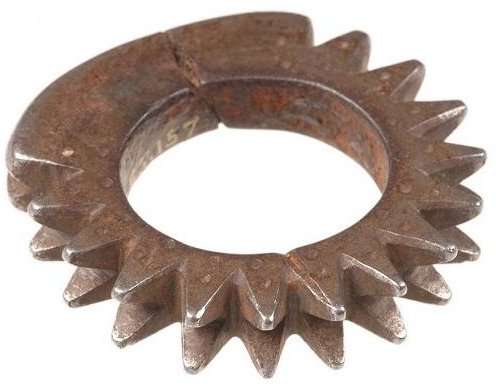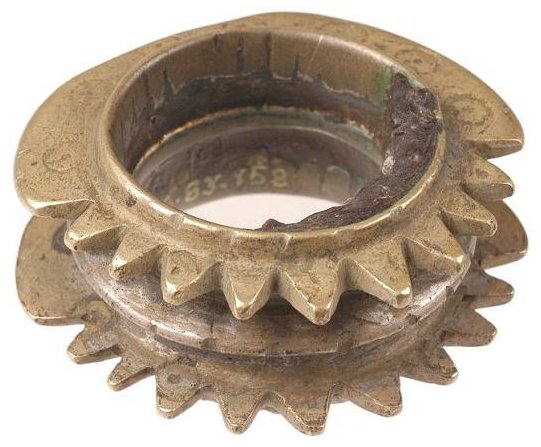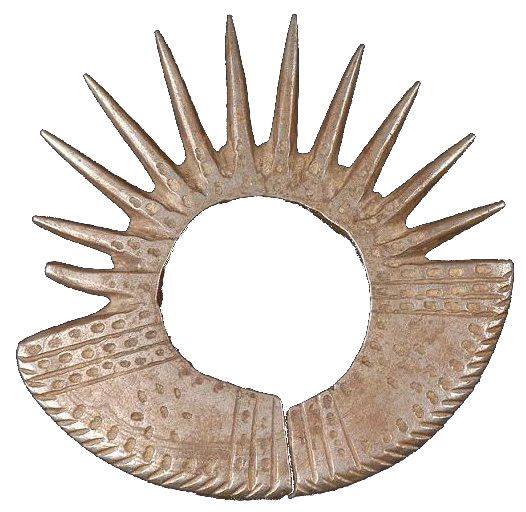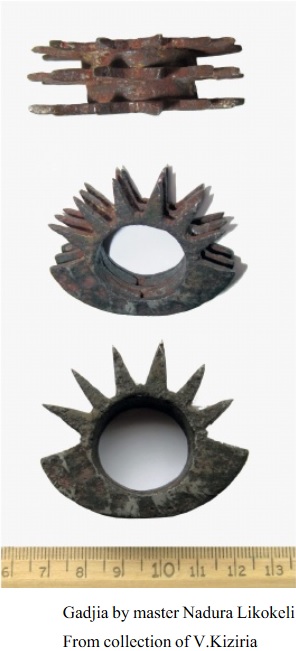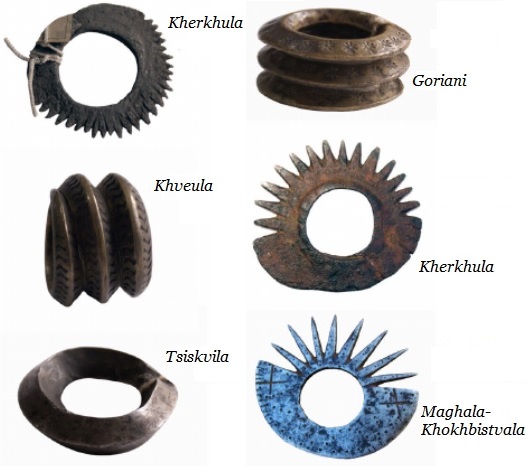Spiked knuckleduster-rings, chain-mail and crosses
THE KHEVSUR CRUSADER MYTH
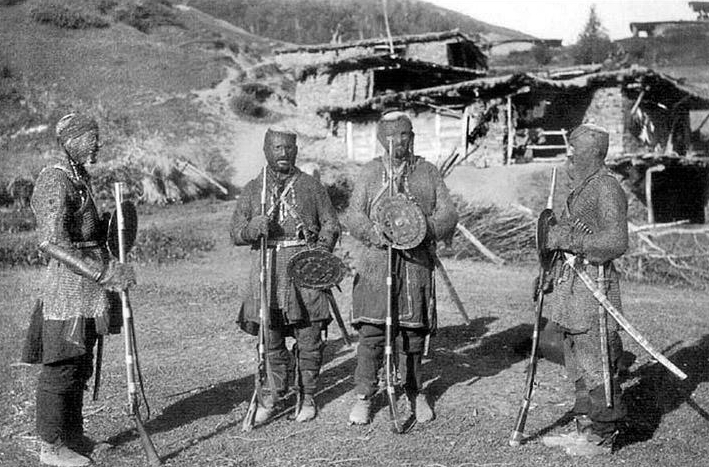
Over the years, many authors—their imaginations fired up by the supposèd resemblance between Khevsur weapons and mediaeval European arms and the Khevsur custom of decorating not only weapons but also clothes, &c. with crosses—have argued that the Khevsurs of northern Georgia are the descendants of Crusaders who settled in the Caucasus mountains:
IF ASKED TO NAME THE HIGHEST MOUNTAINS IN EUROPE, many persons would suggest Mont Blanc or the Matterhorn, without realizing perhaps that there is in Europe a range of mountains which possess no less than nine peaks higher than the highest Alpine summit. This range is the little-known Caucasus Mountains, lying between the Black Sea and the Caspian Sea, and separating Europe from Asia; its highest summit is Mount Elbruz, 18,526 feet high, or nearly three thousand feet higher than Mont Blanc.
This great mountain barrier is a region of contrast and contradiction, with scenery ranging from snowfields reminiscent of the Arctic to deep valleys filled with fields of tobacco, cotton and other tropical plants. An equal variation is shown in the various tribes and races which inhabit this region and who speak many different languages. Since the dawn of recorded history the Caucasus has been racially a sort of No-Man's-Land, a place of refuge "where fragments of forgotten peoples dwelt" and to which there drifted during the centuries odd tribes of Turks, Tartars, Persians and others. I remember even encountering a number of negroes, who looked very much like their counterparts one sees among the cotton fields of the southern United States, and was told that they were the descendants of a shipload of slaves which had been wrecked on the shores of the Black Sea nearly two and a half centuries ago.
The Caucasus have their full share of legends of curious peoples who live in the almost-inaccessible heart of the mountains, cut off from the outer world by high peaks and deep gorges. Mount Elbruz was reputed, by tradition, to be the resting-place of the Ark of Noah, after the Flood. Another and most persistent legend concerned the existence of a race descended from a party of Crusaders who lost their way while trying to reach the Holy Land in the twelfth century. They had retained the armour, shields and swords used by their Crusading ancestors, and employed these on raids among the neighbouring peoples of Daghestan.
That this was more than a legend was proved during the First World War, when Russian agents reached the remote Khevsoor Valley where these people dwelt. The various tribes inhabiting the Caucasus had long resisted the advance of the Russians, and thought the region finally became incorporated in the Russian Empire, much of it remained unknown and unexplored. During the First World War the region was the scene of prolonged fighting between the Russians and the Turks, and a party of Khevsoors wearing armour and carrying shields and broadswords actually rode into Tiflis, the capital of Georgia, to offer their services in the fight against the infidels. Since then the Caucasus have become incorporated in a group of Socialist Soviet republics, including Armenia, Azerbaijan, Abkhazia, Daghestan, and others; roads have been built, schools and hospitals established, and other benefits of civilization imposed upon the not always grateful Khevsoors.
I first heard of the Khevsoors while on a visit to Tiflis, now known as Thilisi [sic], some years before the outbreak of the Second World War, and made an unsuccessful attempt to reach the remote valley in which they lived. One was able to go by car to a point about ninety miles north of Tiflis, but from there the route was along a rough trail accessible only to persons on foot or on horseback. It was a difficult and even dangerous journey, for the trail winds along the edge of steep cliffs and canyons. When the pass is blocked by ice and snow the valley is quite inaccessible.
Unfortunately, it was already late in the year when I made my attempt, and it was beginning to snow when we started to cross the ridge which separates the valley from the outside world. My guide warned me that it was foolhardy to continue, as even if we reached the nearest Khevsoor village in safety we might be unable to return, and would have to remain there until the following spring. For five months of the year the valley is completely isolated. So, reluctantly, I was compelled to forgo a visit to these strange people, and I turned back. But as I had managed to gather a certain amount of information about the Khevsoors and their history my journey was not entirely wasted.
Since then the Soviets have gradually extended their influence in the mountains, imposing a policy of collectivization upon the various tribes, and educating and developing them in accordance with the best Marxist principles; so it is quite possible that the Khevsoors, as an interesting and unique survival of the past, no longer exist.
Outwardly the Khevsoors, or Khesurs, differ but little from a score of other clans and tribes which dwell in the Caucasus. They are grouped in a number of villages, each living a communal life, and largely dependent on their herds of sheep, goats and cattle. Barley is their main crop. They are largely self-supporting, they produce most of their own food, build their own stone houses, make their own tools and clothing. In appearance they are tall and wiry, and wear the home-spun shirts, baggy trousers and black sheepskin hats common to the men of the mountains. It was the custom for each man to carry a rifle and have a couple of cartridge belts criss-crossed across his chest.
What does distinguish the Khevsoors from their neighbours are the suits of ancient chain armour and swords inscribed with the letters "A.M.D." (which might mean Ave Mater Dei, i.e., Hail, Mother of God), a system of duelling governed by a rigid code of ethics, and their legendary descent from the Crusaders.
According to this legend a party of Crusaders from Lorraine, under the leadership of Godfrey of Bouillon while trying to reach the Holy Land, were shipwrecked on the shores of Turkey. Cut off from the main party of Crusaders by a horde of Saracens they had no choice but to retreat inland, and eventually reached the Caucasus. Unable to find the way back, they seized women from neighbouring villages, and settled down where they were. And there their descendants have remained. There seems little reason to doubt the truth of this legend, but should anyone do so, then they will have to explain the armour, the swords and the system of duelling.
I was told that the armour was genuine twelfth-century date and of French make. The chain armour was formed of thousands of hammered iron links, constituting a flexible garment which fitted the body like a shirt. A helmet made of the same material was drawn over the head, and long gauntlets for the arms and greaves to cover the legs completed the protection. Each outfit weighed about thirty pounds. The armour was worn only on ceremonial occasions, and when not in use hung on a nail in the living-room of the house.
Attempts have been made to manufacture suits of mail from copper wire stolen from the telegraph line running alongside the highway from Tiflis, but these had not proved very successful as they did not provide sufficient protection from sword thrusts. The original armour was now getting very rusty and dilapidated as the owners did not know how to preserve it properly. Their swords, incidentally, were about thirty inches long and were straight, two-edged weapons of typical Crusader type. The shields were small and circular, about eighteen inches in diameter, and made of leather embossed with a crude Crusader cross.
Duelling is also a legacy from the long-distant pass, and is conducted according to centuries-old rules. As well as being the accepted way of settling disputes, it is also regarded as a sport, and part of the training which every boy and young man must undergo. Duelling is, in fact, almost the only sport or diversion open to the men of the valley, except getting drunk on barley brandy or raiding Daghestan villages and driving off their cattle (and nowadays the local soviet government discourages these activities and sends the raiders to jail). The Khevsoors fight for the sheer joy of it, and need little or no excuse to put on their armour and have a whack at each other with their long swords.
My guide over the mountains described to me how such a duel was conducted. Duels take place on an open space outside the village. Dressed in their armour the two combatants faced each other, shield in one hand, broadsword in the other. At the sign to "Begin" they leap at each other, slashing and stabbing, parrying blows, whirling round and round like a couple of fighting-cocks. The sword blades clash against each other, slither across the armour, or rattle against the leather shields, which are used for parrying blows rather than taking their full force. As both fighters may have had a good swig of brandy before the duel commenced, many blows go wild, and although the noise and the excitement are considerable, little actual damage is done.
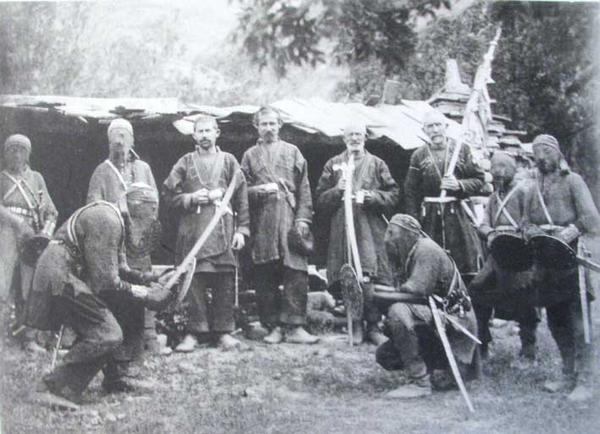
These hand-to-hand combats differ in one respect from the jousts and tournaments of Crusading times, when women as well as men were spectators; here only men are allowed to watch, except on certain occasions. Yet curiously enough, one custom from the Middle Ages which has been retained is that of allowing a woman to stop a duel by dropping her handkerchief between the two fighters. As wounds or serious damage are rare, this seldom happens; for usually a few bruises are the only outcome. In more serious cases, when a man is badly wounded, his opponent has to pay compensation, usually a certain number of cows. [See http://www.batsav.com/pages/adolf-dirr-trepanation-as-legal-evidence-in-the-caucasus.html for a table setting out compensation in cows, &c. for injuries to the head—A.B.]
COOPER, Gordon, Dead Cities and Forgotten Tribes (London: Lutterworth Press, 1952)
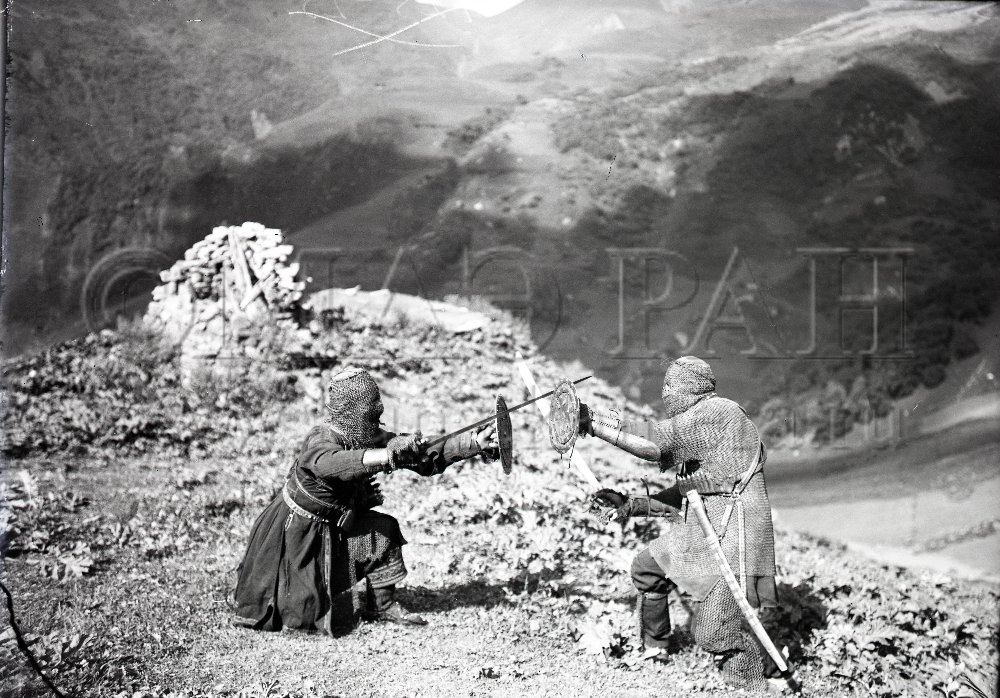
"Scene of swordcraft"
© Peter the Great Museum of Anthropology and Ethnography
of the Russian Academy of Sciences
Alexander Grigolia, in his Custom and Justice in the Caucasus: The Georgian Highlanders ('A dissertation in anthropology presented to the faculty of the graduate school of the University of Pennsylvania in partial fulfillment of the requirements for the degree of Doctor of Philosophy'; Philadelphia: 1939) also sums up the (erroneous) views of several other authors:
DRASTIC AND CONTRARY VIEWS HAVE BEEN EXPRESSED, especially concerning the origin of the Khevsurs, who attracted the attention of investigators by their habits of dress—the coat of mail with crosses on their garments, their arms, their manner of living, and the differences in their physical features. The current opinion in times past was to see in them the descendants of the Crusaders who, it was supposed, were driven out of Palestine after their defeat and found refuge and safety in the inaccessible mountain regions of the Caucasus. At first this theory was brought into literature by the Russian writer, A.L. Zisserman. Taking into consideration the peculiar dress of the Khevsurs—their coat of mail with the signs of the cross and the arms—especially the sabres with the inscriptions: Solingen, Vivat Husar, Vivat Stephen Batory, Gloria Dei, &c., Zisserman expresses in his book the opinion of the possible origin of the Khevsurs from the Crusaders who found their refuge, as he thinks, in the secluded mountains of the Caucasus and intermarried with the women of the neighbouring tribes and were joined by many fugitives from the other peoples of the country.
The opinions expressed by Mr Zisserman were followed by representatives of other nations. The French investigators saw in the Georgian Khevsurs the descendants of French ancestors; the Germans, of the Germans; and the Russians, of the Russians.
Thus, for example, the French traveller, M. Taitbout de Marigny, regards the Khevsurs as the descendants of the French Crusaders, who, as he erroneously asserts, had brought Christianity to the pagan peoples of the Caucasus, and opinion which exposes his ignorance of the history of the country. As convincing "proof" of his opinion, he brings out the custom of the Khevsurs of wearing signs of the cross on their dresses, which, as he thinks, represents the crosses of the Sacred Order of Malta. Furthermore, he points out what he considers to be the presence of French family names among the Khevsurs, such as Devilete and Guillot. 'On n'a, je crois, rien de très positif,' writes M. Taitbout de Marigny, 'sur l'époque où le christianisme fut introduit dans le Caucase et quels furent ceux qui le prêchèrent à ces peuples idolâtres. Une opinion assez commune attribue cette espèce d'apostolat à des Croisés échappés aux malheurs de leurs expéditions dans la Terre Sainte. La petite peuplade de Khevsur, située dans le Caucase après des Ossétiniens, porte sur ses habits des croix de Malte en drap rouge et sur ses boucliers de fer, elle en a de peints de la même couleur. L'on remarque aussi chez elle des noms français: tels que Devilete, Guillot.'
On the other hand, the German investigator, N.A. Busch, is convinced that among the ancestors of the Khevsurs were also the German Crusaders. Discussing at first the opinion of A.L. Zisserman concerning this question, he adds: 'Ich möchte noch weiter gehen und annehmen daß unter den Vorfahren der Chewsuren Deutsche gewesen sind, etwa die Nachkommen der Kreuzfährer...' In confirmation of his opinion the author sees not only the knightly arms, but also: (1) the presence among the Khevsurs of tall blond men; (2) the veneration of the cross with manifestations reminiscent of Catholic usages; (3) the sacred beer; and (4) the silver cups with engraved Gothic buildings on them.
[...]
Especially peculiar are the views of the celebrated Russian archaeologist, the Countess P.S. Uvarov, who visited the country of the Khevsurs in the summer of 1890 and saw, as she thinks, in the Khevsurs the "real" and "unquestionable" representatives of the historically famous Cossacks of the Dniepr River—the Zaporojtsi.
'Many times I was told,' writes the author, 'that the Khevsurs are the descendants of the Crusaders and that the principal adornment of their dress is the cross. I think that such supposition is the result of sheer fantasy, used, to our regret, very often during the scientific investigations of the antiquities of the Caucasus, its peoples and ethnology. That the Khevsurs are not Georgians and are not of Georgian origin is for me an irrefutable fact; but in the meantime to see in them the descendants of the Crusaders is very difficult, because nothing confirms this opinion; neither the type of Khevsurs nor their character or customs. And as for their use at the present time of armour plate and the sign of the cross in their ornaments, the first is probably borrowed, not from the West but from the East (the elbow-pieces are of Oriental origin), and the second is used in the same manner as by the peoples of Slavonic origin. The type of the Khevsur is rather reminiscent of a Zaparojets or a Scythian and Sarmatian from the Trojanic column: the same boots, the same trousers, the straight broadsword, the thick hair on the head cut in round, circular form, the same moustaches, the short beards, the virile expression of the faces, and the tress of hair of the ancient Zaparojtsi.
GRIGOLIA, Alexander, Custom and Justice in the Caucasus: The Georgian Highlanders (Pennsylvania: 1939)
Richard Halliburton, the American adventurer and writer, also wrote a rather entertaining chapter on a visit he paid to the Khevsurs in the early 1930s (probably; his book, Seven League Boots, was published in 1935), which begins with the usual legend of the Khevsurs being descended from Crusaders who became separated from the main Christian forces they were accompanying and ended up establishing themselves in the Caucasus:
CHAPTER EIGHTEEN
The Last of the Crusaders
THE CITY OF TIFLIS, capital of the state of Georgia in Caucasia, has long prided itself upon its advanced ideas, its broad boulevards, its modern architecture, and its progressive-minded citizens.
The shock was all the greater, therefore, when, in the spring of 1915, some months after Russia's declaration of war against Turkey, a band of twelfth-century Crusaders, covered from head to foot in rusty chain armour and carrying shields and broadswords, came riding on horseback down the main avenue.
People's eyes almost popped out of their heads. Obviously there was no cinema company going on location. These were Crusaders—or their ghosts.
The incredible troop clanked up to the governor's palace.
'Where's the war?' they asked. 'We hear there's a war.'
They had heard in April 1915 that there was a war. It had been declared in September 1914. The news took seven months to reach the last of the Crusaders.
And you wouldn't be surprised, if you tried, as Fritz and I did, to find the behind-the-beyond country in which these twelfth-century people live.
One of the most curious and romantic legends of the Caucasus tells the story of the origin of this armoured tribe. And as yet no historian has found any reason to believe that the legend is not based entirely on fact. The story declares that this race came, eight hundred years ago, from Lorraine, more than two thousand miles away. The argument is borne out by the fact that their chain armour is in the French sty;e, while their otherwise incomprehensible speech still contains six or eight good German words.
When they left Lorraine, so goes the legend, the last thing they had in mind was the colonization of the frosty peaks of the Caucasus Moutnaints, for they were followers of Godfrey de Bouillon and planned to wrest the Holy Sepulchre from the Moslem infidels.
But during the thousand-mile march across what is now Asiatic Turkey, this particular band of Crusaders somehow got detached from the main army, and were prevented by the Saracens from rejoining it. Whether they took a northern course of their own accord, and continued on across Armenia and Georgia to the Caucasus as pioneers, or whether they were fleeing for their lives with Moslem scimitars swishing around their ears, the legend does not say. But we do know that they called a halt in one of the most rugged and unapproachable corners of the Caucasus... and didn't emerge again in force till 1915 when the rumours of a worth-while war brought them, wearong their ancestors' coats of mail, into Tiflis.
All very fanciful, of course, but an almost identical event really did take place in 1921, when around a hundred Khevsurs rode down into Tbilisi to join Georgia's (ultimately futile) fight to preserve its independence following the country's invasion by the Soviet Union. The following photograph (held by the Georgian National Archives) shows some of these brave men.
.jpg)
KHEVSUR FIGHTING RINGS
The following are photographs of a traditional Khevsur weapon called a ghaj'ia or satseruli (G. ღაჯია, საცერული)—a sort of spiked knuckleduster-ring worn on the thumb. The first three examples are held in the Collection Joseph Berthelot de Baye of the Musée du Quai Branly in Paris; the fourth was spotted by the eagle-eyed William Dunbar in the Pitt-Rivers Museum in Oxford; the fifth was found in Irine Elizbarashvili, Manana Suramelashvili and Tsitsino Chachkhunashvili's absolutely splendid გამაგრებული ისტორიული დასახლებები საქართველოს ჩრდილოეთ მთიანეთში ('Historical Fortified Settlements in Georgia's Northern Mountainous Regions'; Tbilisi: The George Chubinashvili National Research Centre for Georgian Art History and Heritage Preservation, 2018; p. 58).
|
|
|
|
|---|
|
|
|
|---|
Just how this weapon was used seems to be a bit of a mystery, as the way in which it would be "wielded" in battle (viz. worn on the thumb) would make bringing it to bear on an enemy rather awkward. There are a couple of videos on YouTube (here and here) of Georgian "traditional Caucasian martial arts" enthusiasts explaining how the spiked rings were used in hand-to-hand combat. Dr Radde also ventures (extract below) to describe how the weapon was used.
Fridtjof Nansen (of all people) left a rare, tantalizing account of these thumb-rings on pp. 53 & 54 of his Gjennem Kaukasus til Volga (Oslo: Jacob Dybwads Forlag, 1929; translated by G.C. Wheeler, Through the Caucasus to the Volga, London: George Allen & Unwin Ltd., 1931):
THE MOUNTAIN PEOPLES NEAR
THE MILITARY ROAD
THE GEORGIAN MOUNTAIN TRIBES: THE KHEVSURS
We had now come to a district full of ethnographical interest. West of the White Aragva valley the land of the remarkable Ossetes stretches westwards and northwards to the upper valleys of the Terek and beyond Vladikavkaz. East of the valley dwell Georgian tribes, the Pshavs, and up in the mountain valleys to the north-east the Khevsurs. They still speak old Georgian dialects; but the latter especially, who number around 8,000, must have lived a long time cut off in their mountain gorges. Their name comes from the Georgian khevi (= gorge, cleft). They are still following the customs and ways and superstitions of the Middle Ages. They wear helmets, chain-armour, vambraces and greaves of steel, shields and swords, just like the knights of the Crusades. The helmet is a round steel cap over the upper part of the skull, with a steel net hanging down the back and sides of the head and over the forehead, so that only the eyes and the lower part of the face are left free. On festal occasions, and at martial games and tournaments, they appear in full armour, and so, too, when they fear blood revenge, or when a blood feud between two families or between villages is to be settled by a reconciliation. The reason why these tribes cling to the old weapons is evidently because they have always been living amidst feuds, whether between families or between villages, or with the tribes around them. They are quarrelsome fellows, and always go armed when working out of doors too, usually with shield, sword, dagger and musket.
A curious custom is that the men wear on the right thumb a thick iron ring with heavy spikes on it; it is used for giving blows in a fight, and there is hardly any older man without unsightly scars due to this cause, and in this hideous disfigurement of the face they often surpass even the most damaged German student. The same kind of ring is said to have been in use in the Black Forest and in Upper Bavaria.
In his fantastic Die Chews'uren und ihr Land (ein monographischer Versuch) untersucht im Sommer 1876 (Cassel: Theodor Fischer, 1878), the legendary Dr Gustav Radde also had this to say concerning the Khevsur thumb-rings:
|
Der D a u m e n r i n g e, S a z e r u l i. Es sind das flache Scheibenringe, gewöhnlich aus Eisen, seltener aus Kupfer und Messing gemacht, von 1—2½ Werschock Durchmesser. Sie haben bisweilen auch eine etwas zusammengedrückte Form, oder es verläuft sogar der ungezahnte Basaltheil in gerader Linie fort. In der Mitte dieser Scheibe befindet sich ein Loch, durch welches der Daumen gesteckt werden kann. ¾ Theile der äusseren Peripherie besitzen eine bald dichter, bald weitläufiger von einander gestellte, tief eingefeilte Zahnreihe. Bei den Schlägereien handhabt man mit geballter Faust diese Waffe, und zwar scheint es, wenn ich nach den Narben, die nach dergleichen Schlägen verbleiben, urtheilen soll, dass in zwei Hauptrichtungen der Schlag ausgeführt wird. Die eine geht vom Vorderkopfe über die Stirn und reisst namentlich tief in die vorstehende Nasenspitze ein, die andere fällt seitwärts beim Ohre ein und geht über die Wange. Selten fehlen die durch den Daumenring hervorgerufenen verheilten Schrammen den Köpfen älterer Chewsuren, ja einzeilne unter ihnen sind im Laufe der Zeit mehrmals und arg zerfetzt worden. Zu bemerken ist noch, dass bei den eisernen Ringen die beiden Enden des Ringes flach ausgeschmiedet und über einander geschlagen sind, ohne Vernietung. Ausser dieser Waffe tragen fast alle Chewsuren einen platten, oft sehr massiven Eisen- oder Messing-ring mit scharfen Kanten auf den Daumen. Dieser dient dazu, den nicht selten sehr schwerfälligen Hahn des Gewehres aufzuziehen, auch wohl, um den fest eingetriebenen Ladestock, durch einen seitlich geschickt angebrachten Schlag herauszutreiben. Bisweilen sind diese Ringe in 2—3 Spiralen, deren Ränder sich nicht volkommen berühren, aufgewunden. |
The T h u m b - r i n g, S a t s e r u l i. A flat, disc-like ring, usually made of iron, more rarely of copper and brass, around 4.5-11 cms in diameter. Their shape is occasionally somewhat squashed, and the smooth, spikeless base sometimes even runs in a straight line. A hole, through which the thumb can be inserted, perforates the disk at its centre. Three-quarters of the outer edge are serrated—the filed-out "teeth" sometimes close together, sometimes more widely spaced. During fights, the weapon is wielded with closed fist, and based upon the scars which remain from such fighting, I would venture that the ring is brought to bear upon the adversary in two main ways. One blow runs from the top of the head across the forehead and cuts deeply into the nose, the other falls sideways by the ear and cuts across the cheek. Scars left by the thumb-ring are seldom missing from the heads of older Khevsurs, and some individuals among them have repeatedly suffered horrible wounds over the years. Both ends of the rings made of iron are flattened and hammered together, without rivetting. In addition to this weapon, almost every Khevsur wears a flat, often massive ring of iron or brass with sharp edges on his thumb. This ring is used to help cock the often very stiff hammer of his gun, or to expell the ramrod from the barrel with a smart sideways blow. These rings are sometimes shaped into spirals of 2 or 3 twists, whose edges do not touch each other. |
Radde also makes several references to the scarred and sometimes disfigured faces of many of the Khevsur men he encounters during his journey through their lands (Die Sazeruli-Schrammen fehlten keinem Gesichte, zumal älterer Personen).
"Academia.edu" features (accessed 26th of Jan. 2015) a short, 16-page paper dedicated to satseruli entitled "Gadzhiya—The Weapon of Man" (sic.) written by a certain Nikoloz Abazadze, who seems to have based his research upon various ethnographic books written by Georgian scholars e.g. V. Elashvili, G. Tedoradze, &c., as well as upon conversations with the curator of the Georgian National Museum's weapons department, Mamuka Kapianidze.
In this paper (which begins with the same quotation from Radde; see above), Abazadze distinguishes between different types of satseruli. He begins by pointing out that the term ghajia was erroneously used by various authors (e.g. Tedoradze, Zissermann, Radde, &c.) to refer to fighting rings in general, as the latter had failed to 'distinguish the functional characteristics of different rings... gadjiya in fact is only one type of battle ring'.
Abazadze continues (sic.):
Gadjiya is an iron ring... with three rows of small tines... and can be of three types: tsalpira (single row), orpira (two rows) and sampira (three)... The latter was the most popular because of its multi-purpose use. [...] The weapon was carried in a special small pocket sewn on the shirt. [...] The Khevsur would wear a coat, chokha over the shirt, and thus the gadjiya was hidden from the eyes of a stranger. The advantage of such a weapon was that it always remained with its owner, even during various festivities or during visits when, according to tradition, all other weapons were to be surrendered to his hosts. [...] The most important feature of the gadjiya was its ability to inflict heavily bleeding wounds, unbearable pain and thus, force the opponent to admit the defeat without seriously crippling or killing him. An old Khevsur, Totia Arabuli from the village of Tsinkhada, well-known for his formidable fighting skills, told us that once he had to fight, using only gadjiya, against a man armed with a dagger. This and other similar cases prove that a battle ring can be seen as equal to a dagger, not just an auxiliary weapon.
[...] Gadjiya most probably derives from the word godji, "fang". In addition, Khevsurs divide various types of fighting rings into subgroups and give them names corresponding to their features... lesula ("sharpened"), maghala ("tall"), tsiskvila ("millstone"), kherkhula ("saw-tooth"), khveula ("twisted"), zurgana ("humped")... Thus the rings that belong to the class of maghala can be subdivided into maghala-savartskhela ("tall comb") with taller, thin tines in tight rows, and maghala-khokhbistvala ("tall pheasant's eye") that has a small number of tines decorated with dots which resemble pheasants' eyes. There were rings called maghala-aftari ("tall hyena"), &c.'
|
|
Given the martial nature of Khevsur male society, apparently even small boys had their own rings called nestari ("sting"), which were 'made of wire of different thickness... with specially welded short tines for delivering superficial cuts and scratches'.
Moving on to how the rings were wielded, Abazadze says (sic.):
The technique of blows is rather elaborate. They could be divided into advancing (or counterattacking) and reactive. By the direction of hand movements blows are divided into vertical, i.e. from top to down which is called dakvra, circular - from below to upward, and horizontally sideways, called mosma.
Blows usually followed each other in short series, alternating the attempts to stop and neutralize the opponent attacking hand. The amplitude of series of blows was the shortest possible which gave no opportunity to the opponent to evade the line of attack by ducking down or other defensive move. The attack causing profuse bleeding from the forehead of the opponent was considered effective for it compelled him to give up the fight as flowing blood would block the vision, in other words ‘blinding” him. The duration of the fight was minimum, and witnesses would separate the fighters. It was not allowed to deliver blows to the forbidden areas: the neck, the throat, the face below the forehead; such blows were considered as signs of cowardice.
While one hand was used to deliver blows, the other one would try to block or hold the attacking hand of the opponent (hence reflecting dagger fighting technique), grab his collar or head. The fighter would try to press the opponent’s head to his chest and thus deliver maximum number of blows. The finishing blow ending the fight was the one which would tear off part of sculp, the skin and hair and was called abgrucheba. In order to defend himself from the oncoming blows, one would try to manipulate the distance between himself and the opponent. This was done by bending sideways and back, bending forward, pulling or pushing away the opponent, ducking under the hand of the opponent. Another defense move was blocking the opponent’s striking hand with elbow of the left hand simultaneously keeping a hold of opponents collar, or gripping his armed hand. To free oneself from the grip one would strike the wrist of the opponent’s holding hand. An old Khevsur, Gigia Tsiklauri from the village of Roshki, provided an interesting account of this method. He remembered once when fighting (shugli) he delivered the first counterstroke to the outer side of the opponent’s hand with which he had grabbed his shirt (perangi) close to his neck. The opponent, experiencing sharp pain, lowered his hand giving Gigia a chance to move closer at a convenient distance and to continue his attack.
As for the wounds these rings could inflict:
It should be noticed that many people preferred to fight with daggers or with broadsword rather than with gadjiya because of the nature of wounds inflicted with this weapon. Though wounds were usually skin deep, they were very ragged.
As the Khevsurs themselves admit, it was difficult for doctors (dostakari) to sew up ragged tissue; it was easier to treat dagger wounds. Injuries were treated with herbs and ointments, but healing process was long and painful, sometimes lasting for months. If the wounds were inflicted within permitted area and the skull was not punctured, the winner did not pay any compensation. The loser had to use his own recourses for the treatment and endure sneers for his defeat.
There were times when shugli (fight) could brake out anywhere and without attending witnesses. In the memoirs G. Tedoradze remembers that he witnessed a fight where up to 60 people were involved. When it was over, one person was dead and another fatally wounded. If wounds were inflicted as a result of unfairly delivered blows, the fine was calculated according to the laws of rdzhuli. Every aspect of the fight was taken into consideration: the reason of shugli, age of the parties involved, behavior before and during the fight, character of inflicted wounds. There was a traditional Khevsur method of evaluating the damage. The guilty party had to compensate the victim with as many cows as many grains of wheat could be aligned along the length of the wound. If need be the wounds of both parties were measured, and the guilty one paid the fine based on the difference of their lengths. Compensation was used for treatment of the wounds and appeasement of the victim’s hurt pride. The penalty that was to be paid was a substantial burden upon the family of the guilty person.
[...] In the 1906 issue of Psychology Bulletin, Doctor of Medicine E.V. Ericson wrote that having conducted medical examination of Georgian army recruits he had discovered that 46% of them had scars on their heads from injuries received at various times. The same was reported by doctor G. Tedoradze: 'You will seldom find a Khevsur without scars on his head and face. Those without scars become objects of sneers and mockery. During my expeditions in Khevsureti I interviewed many old men and none of them appeared without scars; some of them had a few dozen of them from different types of weapons. The majority of wounds were on their head and hands. Ninety-two-year-old Batira Kerauli from the village of Khadu told me half jokingly: "It is impossible to grow old without scars. If the person dies without a scar at least from a dog bite, he will not be accepted in the world beyond."'
Unless stated otherwise or obviously not the case, all the text and images on this website are © A.J.T. Bainbridge 2006-2015
Do get in touch! Gmail: alexjtb

